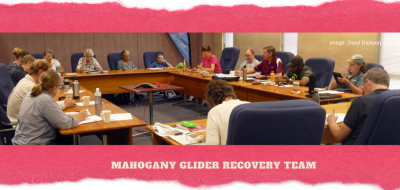17 September 2021
The National Mahogany Glider Recovery Team met in Tully last week, and despite the uncertainty and complexity of remote meetings, cooperation between members was high – all working constructively to improve the future for this endangered species.
Chaired by Wildlife Queensland Cassowary Coast–Hinchinbrook Branch Secretary Suzanne Smith, the meeting was attended by team members from the branch and Townsville Branch, as well as team members from the Girringun Rangers, Terrain NRM, Wet Tropics Management Authority, representatives from local, state and Federal governments, Ergon, Qld Rail, Powerlink, Transport and Main Roads and HQ plantations.
Saving a Southern Wet Tropics Local
First classified in 1883, the mahogany glider went almost entirely unnoticed by science for almost a century until individuals were rediscovered in Queensland’s Wet Tropics in 1989. Identified by their brown ‘mahogany’ belly fur, prominent dorsal stripe, increased size and less fluffy tail than their squirrel glider relatives, mahogany gliders (Petaurus gracilis) are listed as endangered in Queensland and nationally.
The species is endemic to the southern Wet Tropics and has the most restricted distribution of any Australian gliding mammal. The mahogany glider inhabits a 120 km long tract of coastal and tropical lowland eucalypt forest, corymbia and melaleuca woodland, extending from the Hull River, to Tully’s east, to Ollera Creek some 40 km to Ingham’s south-east.
Unfortunately, some 80% of this glider’s habitat has been destroyed, and ongoing fragmentation of its remaining habitat and natural disasters such as tropical cyclones place populations at high risk. The species clings on in pockets of leasehold or private land, with less than half of its existing distribution being in national parks or Crown land.
To persist, the mahogany glider urgently needs active state protection of habitat, greater connection between fragmented habitat, improved fire regimes, better weed control, reduced grazing pressure and the removal of barbed wire on properties within its range.
Awaiting Approval

The Mahogany Glider Recovery Team was grateful for the use of Cassowary Coast Regional Council’s well-equipped Tully facility, which allowed long-distance members and those in lockdown interstate to attend online.
Given the challenges this species faces, writing a new recovery plan is not for the fainthearted. However, under the continued scientific guidance of Dr Steven Jackson, the eight-year process has fostered trust, understanding and cooperation, providing hope – even when the official process is often frustrating.
The new Draft National Mahogany Glider Recovery Plan was completed in May 2020 and closed for public comment on 29 August 2020. It has been sitting with the Federal Minister, awaiting final approval since. The team is hopeful it will be signed soon and the important conservation recommendations actioned under the binding terms of national recovery plans.
Once approved, the plan’s goal is to demonstrate within the next decade progress or achievement of the following success criteria:
1) an increase in the amount of high-quality habitat (i.e. mixed open forest and mixed open woodland) managed for mahogany glider recovery
2) an improved population trajectory
3) the maintenance of genetic diversity
4) an increase in range
5) the restoration of connectivity within 5 identified priority corridors
6) the implementation of Infrastructure and maintenance guidelines across all linear and transport easements
7) the adoption of suitable grazing and fire management regimes by landholders actively engaged in increasing habitat quality across all subpopulations
8) planning decisions informed by emergency triggers and response protocols
9) an increase in community support, recognition of, and participation in recovery programs.
10) the effective coordination of the recovery program with all partners collaborating and contributing to the effective delivery of the plan.
Of course, work has not stopped during the writing of the plan. Seeing team members already cooperate, share resources, plan using priority corridor and habitat mapping, and make the best use of their combined abilities and funding is rewarding, and the National Mahogany Glider Recovery Team has continued to report on actions within the new plan.
Terrain NRM is working with the Australian Government National Landcare Program Biodiversity Bright Spots – Woodlands project to assist JCU PhD student Eryn Chang. Eryn and her colleagues are studying the molecular genetics of the mahogany glider population, and it is hoped her work will provide valuable information about population numbers and the genetic health of remaining gliders.
Meanwhile, Wildlife Queensland’s Cassowary Coast–Hinchinbrook Branch, Townsville Branch and Queensland Glider Network are carrying on with vital on-ground programs for mahogany gliders and other threatened gliding mammals, such as:
- acoustic and camera trap monitoring
- revegetation and corridor native planting projects
- wildlife-friendly fencing and wildlife land-bridges to ease movement between fragmented habitat and reduce mortality rates
- in places, the installation of glider poles that mimic vegetation and allow for safe launch and landing sites to enable gliders to safely navigate open space such as roads or railway lines
- education and community engagement.
Help Us to Help them
To get involved, join your local Wildlife Queensland branch and sign up to receive updates and news from the Queensland Glider Network.
Related articles and information:

